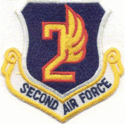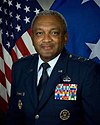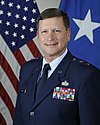Second Air Force
| Second Air Force | |
|---|---|
CMSgt Kristina B. Montgomery |
The Second Air Force (2 AF; 2d Air Force in 1942) is a USAF
History
The Northwest Air District of the
2nd Air Force

On 11 December 1941, four days after the
From December 1941, 2d Air Force organized air defense for the northwest Pacific Ocean coastline of the United States (1940–1941) and flew antisubmarine patrols along coastal areas until October 1942. It appears that immediately after 7 December 1941, only the 7th, 17th,
In January 1942, the 2d Air Force was withdrawn from the Western Defense Command and assigned the operational training of units, crews, and replacements for bombardment, fighter, and reconnaissance operations. It received graduates from Army Air Forces Training Command flight schools; navigator training; flexible gunnery schools and various technical schools, organized them into newly activated combat groups and squadrons, and conducted operational unit training (OTU) and replacement training (RTU) to prepare groups and replacements for deployment overseas to combat theaters.
As the Second Air Force it became predominantly the training organization of
Designated the Second Air Force on 18 September 1942, starting in mid-1943 the unit's training of B-17 and B-24 replacement crews began to be phased out, and reassigned to First, Third and Fourth Air Forces as the command began ramping up training of
A football team made up of Second Air Force personnel defeated Hardin–Simmons University in the 1943 Sun Bowl.[9]
On 13 December 1944, First, Second, Third and Fourth Air Force were all placed under the unified command of the Continental Air Forces (CAF) with the Numbered Air Forces becoming subordinate commands of CAF. The training of B-29 groups and replacement personnel continued until August 1945 and the end of the Pacific War. With the war's end, Second Air Force was inactivated on 30 March 1946. In what was effectively a redesignation, the headquarters staff and resources were used to create Fifteenth Air Force, which became the first Numbered Air Force of the new Strategic Air Command ten days later.
Cold War
The command was reactivated on 6 June 1946 under
The Second Air Force was also assigned the reserve

The Second Air Force was (re)-activated and assigned to
- MacDill AFB, Florida (assigned 10 February 1951)
- 305th Bombardment Wing (MacDill AFB) (B-29)
- B-47 StratojetOperational Training Unit – Not on Operational Alert)
- 307th Bombardment Wing(MacDill AFB) (B-29)
- Detached for Okinawa
- Detached for
- 40th Air Division, Turner AFB, Georgia (assigned 14 March 1951)
- 31st Fighter Escort Wing (Turner AFB) (F-84)
- 108th Fighter Wing (Turner AFB) (F-47D) (Federalized New Jersey Air National Guardwing)
37th and 38th Air Divisions joined Second Air Force on 10 October 1951. 37th Air Division was responsible for
With the end of fighting in Korea, President Eisenhower, who had taken office in January 1953, called for a "new look" at national defense. The result: a greater reliance on nuclear weapons and air power to deter war. His administration chose to invest in the Air Force, especially Strategic Air Command. The
After the Korean War, the history of Second Air Force became part of Strategic Air Command's history, as
During the
With the end of the Cold War and the restructuring of Strategic Air Command, Second Air Force was reactivated and became the steward for reconnaissance and battlefield management assets, based at
Air Education and Training Command
Second Air Force was reactivated and reassigned on 1 July 1993 to
The command has the mission is to train mission ready graduates to support combat readiness and to build 'the world's most respected air, space, and cyberspace force'. To carry out this mission, Second Air Force manages all operational aspects of nearly 5,000 active training courses taught to approximately 250,000 students annually in technical training, basic military training, medical and distance learning courses. Training operations across Second Air Force range from intelligence to computer operations to space and missile operations and maintenance.
The first stop for all Air Force, Air National Guard and Air Force Reserve enlisted airmen is
Commissioned officers attend technical training courses for similar career fields at the same locations.
Wings and Groups under Second Air Force are:
- 37th Training Wing Lackland Air Force Base Texas
Provides Basic Military Training to Air Force recruits as well as technical training in the career enlisted aviator, logistics, and Security Forces career fields. - 81st Training Wing Keesler Air Force Base Mississippi
Provides training in Aviation Resource Management, weather, basic electronics, communications electronic systems, communications computer systems, air traffic control, airfield management, command post, air weapons control, precision measurement, education and training, financial management and comptroller, information management, manpower and personnel. - 17th Training Wing Goodfellow Air Force Base Texas
Provides training in intelligence and firefighting career fields. Also provides training to Army, Navy and Marine detachments. - 82d Training Wing Sheppard Air Force BaseTexas
Provides specialized technical training, medical, and field training for officers, Airmen, and civilians of all branches of the military, other DoD agencies, and foreign nationals. - Vandenberg AFB, California
Provides qualification training for intercontinental ballistic missiles (ICBM), space surveillance, missile warning, spacelift, and satellite command and control operators. It also performs initial and advanced maintenance training on air-launched missiles (ALM) and ICBMs. It conducts training in joint space fundamentals and associated computer maintenance. The group also conducts qualification and orientation training for Air Force Space Command (AFSPC) staff and senior-level personnel, as well as instructor enhancement in support of operational units. - 602d Training Group Keesler Air Force Base Mississippi
Provides fully combat mission capable Airmen to all Combatant Commanders in direct support of the Joint Expeditionary Tasking (JET) mission.
In 2006, Second Air Force was assigned the responsibility of coordinating training for Joint Expeditionary Tasked (JET) Training Airmen. These Airmen are assigned to perform traditional US Army duties in Iraq, Afghanistan and the Horn of Africa. An Expeditionary Mission Support Group was formed to provide command and control of these JET Airmen as they are trained at US Army Power Projection Platforms across the US prior to deploying to their assigned Area of Responsibility (AOR). This group has been named the 602d Training Group.
In 2007, Second Air Force was given responsibility to provide curricula and advice to the Iraqi Air Force as it stands up its own technical training and branch specific basic training among others. This mission is known as "CAFTT" for Coalition Air Forces Technical Training.
Lineage

- Established as Northwest Air District on 19 October 1940
- Activated on 18 December 1940
- Re-designated: 2d Air Force on 26 March 1941
- Re-designated: Second Air Force on 18 September 1942
- Inactivated on 30 March 1946.
- Activated on 6 June 1946.
- Inactivated on 1 July 1948.
- Activated on 1 November 1949.
- Inactivated on 1 January 1975.
- Activated on 1 September 1991.
- Inactivated on 1 July 1993.
- Activated on 1 July 1993
Assignments
|
|
Stations
- McChord Field, Washington, 18 December 1940
- Fort George Wright, Washington, 9 January 1941
- Colorado Springs AAF, Colorado, 13 June 1943 – 30 March 1946
- Fort Crook, Nebraska, 6 June 1946 – 1 July 1948
- Barksdale AFB, Louisiana, 1 November 1949 – 1 January 1975
- Beale AFB, California, 1 September 1991 – 1 July 1993
- Keesler AFB, Mississippi. 1 July 1993 –
Components
Commands
|
|
Divisions
|
|
Wings
- 5th Bombardment Wing: 18 December 1940 – 1 September 1941.
- 11th Pursuit Wing: 18 December 1940 – 1 October 1941.
- 15th Bombardment Training Wing: 23 June 1942 – 6 April 1946 (ceased all activity February 1945).
- 20th Bombardment Wing: 18 December 1940 – 1 September 1941.
Squadrons
- 393rd Bombardment Squadron, Very Heavy: 25 November - 17 December 1944
List of commanders
| No. | Commander | Term | |||
|---|---|---|---|---|---|
| Portrait | Name | Took office | Left office | Term length | |
| 1 | Major General John C. Griffith | 1 July 1993 | 13 June 1995 | 1 year, 347 days | |
| 2 | Major General Henry M. Hobgood | 13 June 1995 | 28 August 1996 | 1 year, 76 days | |
| 3 | Major General Lance W. Lord | 28 August 1996 | 1 August 1997 | 338 days | |
| 4 | Major General Andrew J. Pelak Jr. | 1 August 1997 | 25 August 2000 | 3 years, 24 days | |
| 5 | Major General John F. Regni | 25 August 2000 | 8 July 2004 | 3 years, 318 days | |
| 6 | Major General Lloyd S. Utterback | 8 July 2004 | 9 November 2005 | 1 year, 124 days | |
| 7 | Major General Michael C. Gould | 9 November 2005 | 23 May 2008 | 2 years, 196 days | |
| 8 | Major General Alfred K. Flowers | 23 May 2008 | 29 September 2009 | 1 year, 129 days | |
| 9 | Major General Mary Kay Hertog | 29 September 2009 | 21 July 2011 | 1 year, 295 days | |
| 10 | Major General Leonard A. Patrick | 21 July 2011 | 3 July 2014 | 2 years, 347 days | |
| 11 | Major General Mark Anthony Brown | 3 July 2014 | 26 August 2016 | 2 years, 54 days | |
| 12 | Major General Robert D. LaBrutta | 26 August 2016 | 23 August 2017 | 362 days | |
| 13 | Major General Timothy J. Leahy | 23 August 2017 | 29 August 2019 | 2 years, 6 days | |
| 14 | Major General Andrea Tullos | 29 August 2019 | 30 July 2021 | 1 year, 335 days | |
| 15 | Major General Michele C. Edmondson | 30 July 2021 | Incumbent | 2 years, 263 days | |
References
![]() This article incorporates public domain material from the Air Force Historical Research Agency
This article incorporates public domain material from the Air Force Historical Research Agency
- ^ "Second Air Force (AETC)".
- ^ "Second Air Force > Home".
- ^ "About Us".
- ^ "About Us".
- ^ "Second Air Force (AETC)".
- ^ "Second Air Force (AETC)".
- ^ Senior Airman Kimberly L. Mueller (30 July 2021). "Maj. Gen. Edmondson assumes command of 2nd Air Force". Second Air Force. 81st Training Wing Public Affairs.
- ^ "Factsheet 5 Air Division". Air Force Historical Research Agency. 4 October 2007. Archived from the original on 30 October 2012. Retrieved 12 March 2014.
- ^ Bolding, Mark. "Sun Bowl 1943". mmbolding.com. Archived from the original on 27 August 2009. Retrieved 25 November 2016.
- ^ Serrano, Jose Maria (26 April 2007). "US Strategic Air Command (SAC) 1966". orbat.com. Archived from the original on 23 May 2014. Retrieved 25 November 2016.
- ^ 1966 order of battle
- ^ Air Force Historical Research Agency, Second Air Force Fact Sheet, September 9, 2020.
- Maurer, Maurer (1983). Air Force Combat Units of World War II. Maxwell AFB, Alabama: Office of Air Force History. ISBN 0-89201-092-4.
- Ravenstein, Charles A. (1984). Air Force Combat Wings Lineage and Honors Histories 1947–1977. Maxwell AFB, Alabama: Office of Air Force History. ISBN 0-912799-12-9.
External links
- Second Air Force Factsheet
- News Stories:
- Air Force News: http://www.aetc.af.mil/News/ArticleDisplay/tabid/5115/Article/263318/army-air-force-leaders-examine-in-lieu-of-training.aspx
- Air Force News: http://www.aetc.af.mil/News/ArticleDisplay/tabid/5115/Article/263675/ilo-training-prepares-airmen-to-serve-in-combat-operations.aspx
- Air Force News: Change of Command https://archive.today/20121212040908/http://www.af.mil/news/story.asp?id=123166976
- PRESENTATION TO THE SUBCOMMITTEE ON READINESS COMMITTEE ON ARMED SERVICES UNITED STATES HOUSE OF REPRESENTATIVES: http://www.airforcemag.com/testimony/Documents/2007/July%202007/073107Gibson.pdf
- Air Force Historical Research Agency, Index card for 2 Air Force history, 1941






















